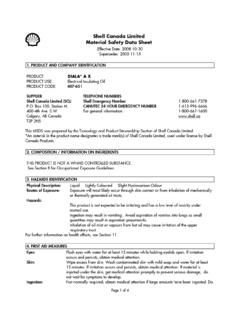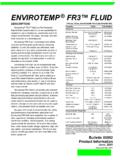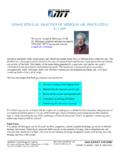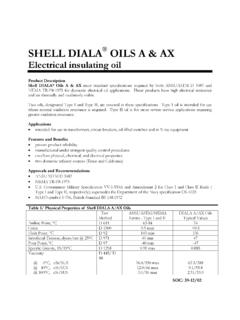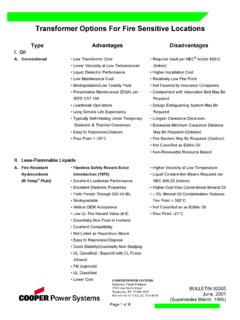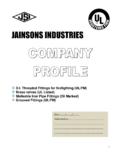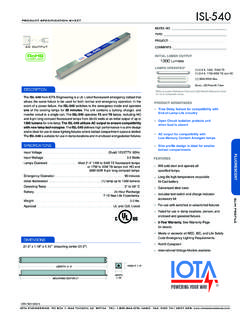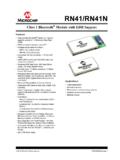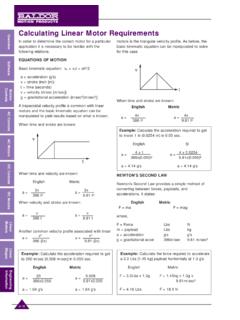Transcription of DOW CORNING CORPORATION Material Safety …
1 DOW CORNING CORPORATION Material Safety Data sheet Page: 1 of 7 DOW CORNING (R) 561 SILICONE TRANSFORMER LIQUID 1. IDENTIFICATION OF THE SUBSTANCE AND OF THE COMPANY Dow CORNING CORPORATION South Saginaw Road Midland, Michigan 48686 24 Hour Emergency Telephone: Customer Service: Product Disposal Information: CHEMTREC: (989) 496-5900 (989) 496-6000 (989) 496-6315 (800) 424-9300 MSDS No.: 01496204 Revision Date: 2002/12/06 Generic Description: Silicone Physical Form: Liquid Color: Colorless Odor: Characteristic odor NFPA Profile: Health 0 Flammability 1 Instability/Reactivity 0 Note: NFPA = National Fire Protection Association 2. OSHA HAZARDOUS COMPONENTS None present. This is not a hazardous Material as defined in the OSHA Hazard Communication Standard. 3. EFFECTS OF OVEREXPOSURE Acute Effects Eye: Direct contact may cause temporary redness and discomfort.
2 Skin: No significant irritation expected from a single short-term exposure. Inhalation: No significant effects expected from a single short-term exposure. Oral: Low ingestion hazard in normal use. Prolonged/Repeated Exposure Effects Skin: No known applicable information. Inhalation: No known applicable information. Oral: No known applicable information. Signs and Symptoms of Overexposure No known applicable information. Medical Conditions Aggravated by Exposure No known applicable information. The above listed potential effects of overexposure are based on actual data, results of studies performed upon similar compositions, component data and/or expert review of the product. Please refer to Section 11 for the detailed toxicology information. DOW CORNING CORPORATION Material Safety Data sheet Page: 2 of 7 DOW CORNING (R) 561 SILICONE TRANSFORMER LIQUID 4.
3 FIRST AID MEASURES Eye: Immediately flush with water. Skin: No first aid should be needed. Inhalation: No first aid should be needed. Oral: No first aid should be needed. Comments: Treat symptomatically. 5. FIRE FIGHTING MEASURES Flash Point: > F / > 101 C (Closed Cup) Autoignition Temperature: Not determined. Flammability Limits in Air: Not determined. Extinguishing Media: On large fires use dry chemical, foam or water spray. On small fires use carbon dioxide (CO2), dry chemical or water spray. Water can be used to cool fire exposed containers. Fire Fighting Measures: Self-contained breathing apparatus and protective clothing should be worn in fighting large fires involving chemicals. Determine the need to evacuate or isolate the area according to your local emergency plan. Use water spray to keep fire exposed containers cool.
4 Unusual Fire Hazards: None. Hazardous Decomposition Products Thermal breakdown of this product during fire or very high heat conditions may evolve the following hazardous decomposition products: Carbon oxides and traces of incompletely burned carbon compounds. Silicon dioxide. Formaldehyde. 6. ACCIDENTAL RELEASE MEASURES DOW CORNING CORPORATION Material Safety Data sheet Page: 3 of 7 DOW CORNING (R) 561 SILICONE TRANSFORMER LIQUID Containment/Clean up: Determine whether to evacuate or isolate the area according to your local emergency plan. Observe all personal protection equipment recommendations described in Sections 5 and 8. For large spills, provide diking or other appropriate containment to keep Material from spreading. If diked Material can be pumped, store recovered Material in appropriate container. Clean up remaining materials from spill with suitable absorbant.
5 Clean area as appropriate since some silicone materials, even in small quantities, may present a slip hazard. Final cleaning may require use of steam, solvents or detergents. Dispose of saturated absorbant or cleaning materials appropriately, since spontaneous heating may occur. Local, state and federal laws and regulations may apply to releases and disposal of this Material , as well as those materials and items employed in the cleanup of releases. You will need to determine which federal, state and local laws and regulations are applicable. Sections 13 and 15 of this MSDS provide information regarding certain federal and state requirements. Note: See section 8 for Personal Protective Equipment for Spills. Call Dow CORNING CORPORATION , (989) 496-5900, if additional information is required. 7. HANDLING AND STORAGE Use with adequate ventilation. Avoid eye contact.
6 Use reasonable care and store away from oxidizing materials. 8. EXPOSURE CONTROLS / PERSONAL PROTECTION Component Exposure Limits There are no components with workplace exposure limits. Engineering Controls Local Ventilation: None should be needed. General Ventilation: Recommended. Personal Protective Equipment for Routine Handling Eyes: Use proper protection - Safety glasses as a minimum. Skin: Washing at mealtime and end of shift is adequate. Suitable Gloves: No special protection needed. Inhalation: No respiratory protection should be needed. Suitable Respirator: None should be needed. Personal Protective Equipment for Spills Eyes: Use proper protection - Safety glasses as a minimum. Skin: Washing at mealtime and end of shift is adequate. DOW CORNING CORPORATION Material Safety Data sheet Page: 4 of 7 DOW CORNING (R) 561 SILICONE TRANSFORMER LIQUID Inhalation/Suitable Respirator: No respiratory protection should be needed.
7 Precautionary Measures: Avoid eye contact. Use reasonable care. Note: These precautions are for room temperature handling. Use at elevated temperature or aerosol/spray applications may require added precautions. For further information regarding aerosol inhalation toxicity, please refer to the guidance document regarding the use of silicone-based materials in aerosol applications that has been developed by the silicone industry ( ) or contact the Dow CORNING customer service group. 9. PHYSICAL AND CHEMICAL PROPERTIES Physical Form: Liquid Color: Colorless Odor: Characteristic odor Specific Gravity @ 25 C: Viscosity: 50 cSt Freezing/Melting Point: Not determined. Boiling Point: > 65 C Vapor Pressure @ 25 C: Not determined. Vapor Density: Not determined. Solubility in Water: Not determined. pH: Not determined. Volatile Content: Not determined.
8 Note: The above information is not intended for use in preparing product specifications. Contact Dow CORNING before writing specifications. 10. STABILITY AND REACTIVITY Chemical Stability: Stable. Hazardous Polymerization: Hazardous polymerization will not occur. Conditions to Avoid: None. Materials to Avoid: Oxidizing Material can cause a reaction. 11. TOXICOLOGICAL INFORMATION Special Hazard Information on Components No known applicable information. 12. ECOLOGICAL INFORMATION Environmental Fate and Distribution Complete information is not yet available. Environmental Effects DOW CORNING CORPORATION Material Safety Data sheet Page: 5 of 7 DOW CORNING (R) 561 SILICONE TRANSFORMER LIQUID Complete information is not yet available. Fate and Effects in Waste Water Treatment Plants Complete information is not yet available. Ecotoxicity Classification CriteriaHazard Parameters (LC50 or EC50) High Medium Low Acute Aquatic Toxicity (mg/L) <=1 >1 and <=100 >100 Acute Terrestrial Toxicity <=100 >100 and <= 2000 >2000 This table is adapted from "Environmental Toxicology and Risk Assessment", ASTM STP 1179, , 1993.
9 This table can be used to classify the ecotoxicity of this product when ecotoxicity data is listed above. Please read the other information presented in the section concerning the overall ecological Safety of this Material . 13. DISPOSAL CONSIDERATIONS RCRA Hazard Class (40 CFR 261) When a decision is made to discard this Material , as received, is it classified as a hazardous waste? No State or local laws may impose additional regulatory requirements regarding disposal. Call Dow CORNING Corporate Environmental Management, (989) 496-6315, if additional information is required. 14. TRANSPORT INFORMATION DOT Road Shipment Information (49 CFR ) Not subject to DOT. Ocean Shipment (IMDG) Not subject to IMDG code. Air Shipment (IATA) Not subject to IATA regulations. Call Dow CORNING Transportation, (989) 496-8577, if additional information is required.
10 15. REGULATORY INFORMATION Contents of this MSDS comply with the OSHA Hazard Communication Standard 29 CFR TSCA Status: All chemical substances in this Material are included on or exempted from listing on the TSCA Inventory of Chemical Substances. EPA SARA Title III Chemical Listings Section 302 Extremely Hazardous Substances: DOW CORNING CORPORATION Material Safety Data sheet Page: 6 of 7 DOW CORNING (R) 561 SILICONE TRANSFORMER LIQUID None. Section 304 CERCLA Hazardous Substances: None. Section 312 Hazard Class: Acute: No Chronic: No Fire: No Pressure: No Reactive: No Section 313 Toxic Chemicals: None present or none present in regulated quantities. Supplemental State Compliance Information California Warning: This product contains the following chemical(s) listed by the State of California under the Safe Drinking Water and Toxic Enforcement Act of 1986 (Proposition 65) as being known to cause cancer, birth defects or other reproductive harm.
